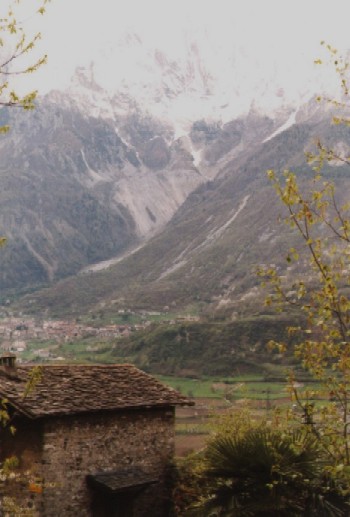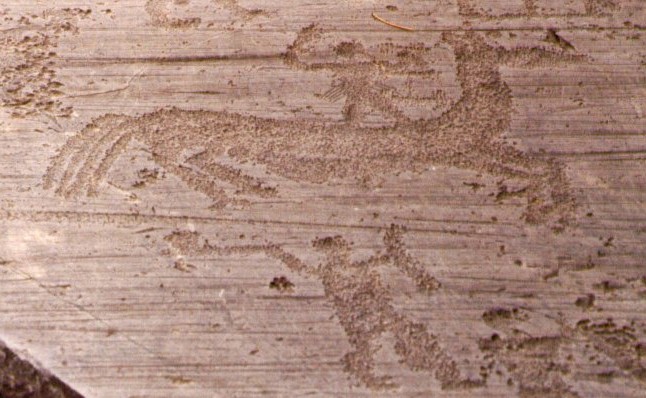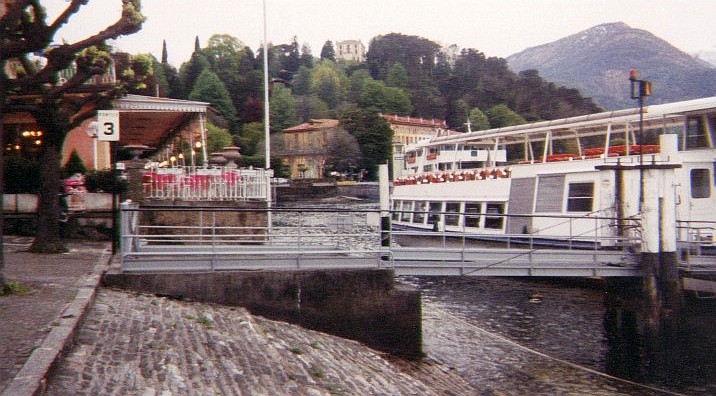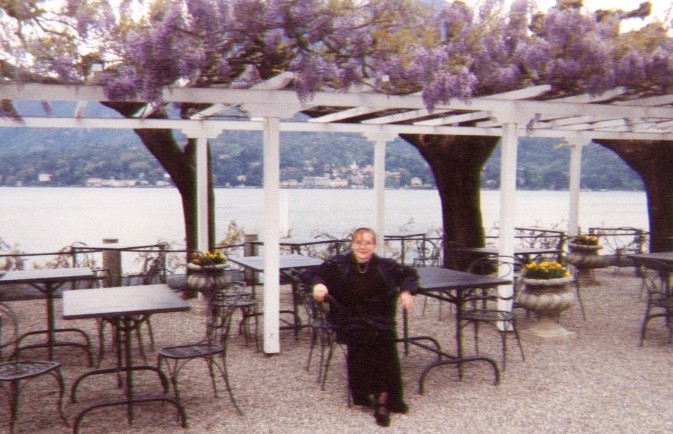
There are only about three roads connecting the valley that Livigno
is in with the rest of Italy. Two of them were closed for the season
still so we followed the road through Bormio down into the lake district
of Italy. Once out of the higher Alps, we crossed one more valley to
the east so that we could drive down the Valle Camonica shown here. As
you can see, the mountains tower over the center of the valley. The
town in this photo is Capo di Ponte.

The main reason we visited this valley however, is the rock art sites that
can be found throughout it. Parco Nazionale Incisione dei Rupestri
contains the greatest concentration of these, and is located precariously
high up on one side of the valley. For the record, you are supposed to park
at the bottom and hike up to the top. We had a few problems deciphering
those instructions out of Italian so we not only drove up the little
cobblestone path to the top - we also went back down it in reverse.
Incidentally, we know nothing about the church in this picture. It is
visible across the valley from the national park.

There are over 140,000 petroglyphs in this valley. The
inscriptions are not deep, and thus can be difficult to see, even standing
in front of the rock. The range in the valley is phenomenal, from
paleolithic animals and neolithic designs all the way to Roman inscriptions.
Those pictured here are Iron Age figures. At right is the so-called
'Deer God' believed to represent the forces of nature. Other common subjects
include duels, boats, dogs and weapons.

The park itself is heavily forested and nearly every rock too big to be
carried off has inscriptions on it. After staring at highlighted areas
of certain rocks for some time we decided that you might have to be a
trained archeologist to see some of them. Particularly interesting, some
rocks had original iron age carvings with later inscriptions added by
Roman legions who visited the area.

From renaissance Venice to medieval Switzerland to prehistoric rock drawings,
we had now run out of history going backwards, so the only thing to do was
head for the nearest resort area and have one last good dinner before we left
Italy. Our choice for this was Bellagio, a town on the end of a peninsula
which juts out into Lake Como. Bellagio is perched on the side of a cliff that
comes down to the lake (which can be seen briefly in this picture). As a result
roads going towards the lake are basically cobblestone stairways. The lower
floors of buildings contain restaurants and shops. Particularly common in the
shops here are leather goods, estate jewelry, and amber. We stayed about a
mile or two out of town and drove back in for dinner. The town seems to be
particularly popular with British tourists and in season (summer) is quite
crowded (or so we were told).

From the surrounding hills, various villas surrounded by Lombard poplar trees
look out at the lake. Ferries also criss-cross the lake connecting all the
villages along the shores. We ate dinner in a restaurant where nearly every
other patron was English-speaking. We had been somewhat unaware that Bellagio
was quite so popular, but we'd chosen it based on a magazine article, so perhaps
everyone else had read it too. For dinner, David had what was quite clearly
the best bolognese sauce imaginable. We also both had affogato for dessert.
We haven't mentioned that yet, but it is an Italian concoction of ice cream
and espresso and it will definately leave you awake and something like alert.

We stayed at the Hotel Silvio, and there is no hotel we stayed at on
this trip we would recommend more than this one. The staff was incredibly
friendly and helpful, the rooms have balconies overlooking the lake and
surrounding hills, and the public areas are fantastic. We spent the
evening in between the bar and the fireplace (which was complete with
sleeping dogs) sampling a variety of amaro liquors. Amaro literally means
'bitter' and is an entire class of Italian drinks which are just that.
They do vary considerably however and we found several of them to be excellent.
We left early the next morning to go back to Malpensa, the Milan airport,
which is really not very close to Milan at all. Malpensa can be translated
as 'bad idea' which pretty much sums up the way Italians feel about it. Despite
that we had no problems in Malpensa on the return trip and would instead
recommend that Ft. Lauderdale Int'l airport be renamed Badidea.
 There are only about three roads connecting the valley that Livigno
is in with the rest of Italy. Two of them were closed for the season
still so we followed the road through Bormio down into the lake district
of Italy. Once out of the higher Alps, we crossed one more valley to
the east so that we could drive down the Valle Camonica shown here. As
you can see, the mountains tower over the center of the valley. The
town in this photo is Capo di Ponte.
There are only about three roads connecting the valley that Livigno
is in with the rest of Italy. Two of them were closed for the season
still so we followed the road through Bormio down into the lake district
of Italy. Once out of the higher Alps, we crossed one more valley to
the east so that we could drive down the Valle Camonica shown here. As
you can see, the mountains tower over the center of the valley. The
town in this photo is Capo di Ponte.
 There are only about three roads connecting the valley that Livigno
is in with the rest of Italy. Two of them were closed for the season
still so we followed the road through Bormio down into the lake district
of Italy. Once out of the higher Alps, we crossed one more valley to
the east so that we could drive down the Valle Camonica shown here. As
you can see, the mountains tower over the center of the valley. The
town in this photo is Capo di Ponte.
There are only about three roads connecting the valley that Livigno
is in with the rest of Italy. Two of them were closed for the season
still so we followed the road through Bormio down into the lake district
of Italy. Once out of the higher Alps, we crossed one more valley to
the east so that we could drive down the Valle Camonica shown here. As
you can see, the mountains tower over the center of the valley. The
town in this photo is Capo di Ponte.
 The main reason we visited this valley however, is the rock art sites that
can be found throughout it. Parco Nazionale Incisione dei Rupestri
contains the greatest concentration of these, and is located precariously
high up on one side of the valley. For the record, you are supposed to park
at the bottom and hike up to the top. We had a few problems deciphering
those instructions out of Italian so we not only drove up the little
cobblestone path to the top - we also went back down it in reverse.
Incidentally, we know nothing about the church in this picture. It is
visible across the valley from the national park.
The main reason we visited this valley however, is the rock art sites that
can be found throughout it. Parco Nazionale Incisione dei Rupestri
contains the greatest concentration of these, and is located precariously
high up on one side of the valley. For the record, you are supposed to park
at the bottom and hike up to the top. We had a few problems deciphering
those instructions out of Italian so we not only drove up the little
cobblestone path to the top - we also went back down it in reverse.
Incidentally, we know nothing about the church in this picture. It is
visible across the valley from the national park.
 There are over 140,000 petroglyphs in this valley. The
inscriptions are not deep, and thus can be difficult to see, even standing
in front of the rock. The range in the valley is phenomenal, from
paleolithic animals and neolithic designs all the way to Roman inscriptions.
Those pictured here are Iron Age figures. At right is the so-called
'Deer God' believed to represent the forces of nature. Other common subjects
include duels, boats, dogs and weapons.
There are over 140,000 petroglyphs in this valley. The
inscriptions are not deep, and thus can be difficult to see, even standing
in front of the rock. The range in the valley is phenomenal, from
paleolithic animals and neolithic designs all the way to Roman inscriptions.
Those pictured here are Iron Age figures. At right is the so-called
'Deer God' believed to represent the forces of nature. Other common subjects
include duels, boats, dogs and weapons.
 The park itself is heavily forested and nearly every rock too big to be
carried off has inscriptions on it. After staring at highlighted areas
of certain rocks for some time we decided that you might have to be a
trained archeologist to see some of them. Particularly interesting, some
rocks had original iron age carvings with later inscriptions added by
Roman legions who visited the area.
The park itself is heavily forested and nearly every rock too big to be
carried off has inscriptions on it. After staring at highlighted areas
of certain rocks for some time we decided that you might have to be a
trained archeologist to see some of them. Particularly interesting, some
rocks had original iron age carvings with later inscriptions added by
Roman legions who visited the area.
 From renaissance Venice to medieval Switzerland to prehistoric rock drawings,
we had now run out of history going backwards, so the only thing to do was
head for the nearest resort area and have one last good dinner before we left
Italy. Our choice for this was Bellagio, a town on the end of a peninsula
which juts out into Lake Como. Bellagio is perched on the side of a cliff that
comes down to the lake (which can be seen briefly in this picture). As a result
roads going towards the lake are basically cobblestone stairways. The lower
floors of buildings contain restaurants and shops. Particularly common in the
shops here are leather goods, estate jewelry, and amber. We stayed about a
mile or two out of town and drove back in for dinner. The town seems to be
particularly popular with British tourists and in season (summer) is quite
crowded (or so we were told).
From renaissance Venice to medieval Switzerland to prehistoric rock drawings,
we had now run out of history going backwards, so the only thing to do was
head for the nearest resort area and have one last good dinner before we left
Italy. Our choice for this was Bellagio, a town on the end of a peninsula
which juts out into Lake Como. Bellagio is perched on the side of a cliff that
comes down to the lake (which can be seen briefly in this picture). As a result
roads going towards the lake are basically cobblestone stairways. The lower
floors of buildings contain restaurants and shops. Particularly common in the
shops here are leather goods, estate jewelry, and amber. We stayed about a
mile or two out of town and drove back in for dinner. The town seems to be
particularly popular with British tourists and in season (summer) is quite
crowded (or so we were told).
 From the surrounding hills, various villas surrounded by Lombard poplar trees
look out at the lake. Ferries also criss-cross the lake connecting all the
villages along the shores. We ate dinner in a restaurant where nearly every
other patron was English-speaking. We had been somewhat unaware that Bellagio
was quite so popular, but we'd chosen it based on a magazine article, so perhaps
everyone else had read it too. For dinner, David had what was quite clearly
the best bolognese sauce imaginable. We also both had affogato for dessert.
We haven't mentioned that yet, but it is an Italian concoction of ice cream
and espresso and it will definately leave you awake and something like alert.
From the surrounding hills, various villas surrounded by Lombard poplar trees
look out at the lake. Ferries also criss-cross the lake connecting all the
villages along the shores. We ate dinner in a restaurant where nearly every
other patron was English-speaking. We had been somewhat unaware that Bellagio
was quite so popular, but we'd chosen it based on a magazine article, so perhaps
everyone else had read it too. For dinner, David had what was quite clearly
the best bolognese sauce imaginable. We also both had affogato for dessert.
We haven't mentioned that yet, but it is an Italian concoction of ice cream
and espresso and it will definately leave you awake and something like alert.
 We stayed at the Hotel Silvio, and there is no hotel we stayed at on
this trip we would recommend more than this one. The staff was incredibly
friendly and helpful, the rooms have balconies overlooking the lake and
surrounding hills, and the public areas are fantastic. We spent the
evening in between the bar and the fireplace (which was complete with
sleeping dogs) sampling a variety of amaro liquors. Amaro literally means
'bitter' and is an entire class of Italian drinks which are just that.
They do vary considerably however and we found several of them to be excellent.
We left early the next morning to go back to Malpensa, the Milan airport,
which is really not very close to Milan at all. Malpensa can be translated
as 'bad idea' which pretty much sums up the way Italians feel about it. Despite
that we had no problems in Malpensa on the return trip and would instead
recommend that Ft. Lauderdale Int'l airport be renamed Badidea.
We stayed at the Hotel Silvio, and there is no hotel we stayed at on
this trip we would recommend more than this one. The staff was incredibly
friendly and helpful, the rooms have balconies overlooking the lake and
surrounding hills, and the public areas are fantastic. We spent the
evening in between the bar and the fireplace (which was complete with
sleeping dogs) sampling a variety of amaro liquors. Amaro literally means
'bitter' and is an entire class of Italian drinks which are just that.
They do vary considerably however and we found several of them to be excellent.
We left early the next morning to go back to Malpensa, the Milan airport,
which is really not very close to Milan at all. Malpensa can be translated
as 'bad idea' which pretty much sums up the way Italians feel about it. Despite
that we had no problems in Malpensa on the return trip and would instead
recommend that Ft. Lauderdale Int'l airport be renamed Badidea.